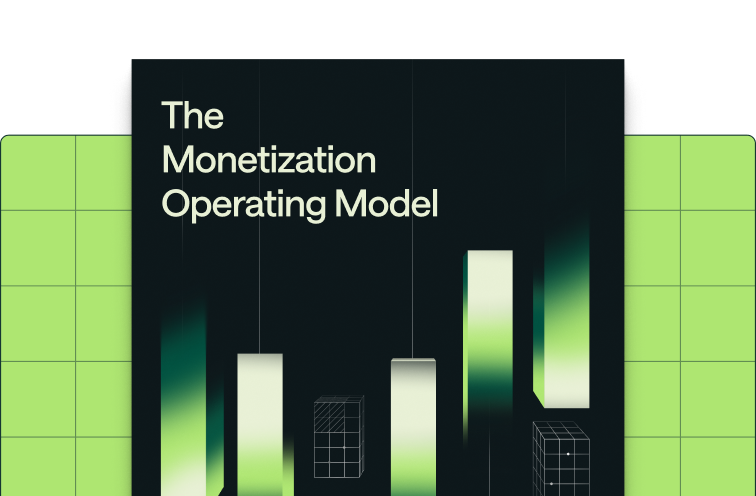Share
Consumption-based pricing works best when aligned with customer value perception. Yet most companies that switch to consumption-based pricing see implementation break down because their billing infrastructure can't handle the operational complexity.
What is consumption-based pricing?
Consumption-based pricing bills customers based on their actual product usage rather than fixed subscription fees. This model aligns pricing directly with value delivery—customers pay more when they use more, less when they use less.
The core principle follows a simple pattern: "Use more, pay more; use less, pay less." This approach originally came from utility companies charging for electricity, gas, and water consumption. Now it's gaining significant traction in SaaS and cloud computing, where companies track specific usage metrics like API calls, storage consumed, or processing time used.
The key difference from subscriptions lies in measurement. Traditional subscription models charge flat access fees regardless of usage intensity. Consumption-based pricing tracks granular usage events and converts them into billing amounts that reflect actual value received.
Consumption-based pricing goes by several synonyms: usage-based pricing, pay-as-you-go (PAYG), metered billing, and flexible consumption pricing. These terms describe the same fundamental approach of linking charges to consumption patterns.
{{widget-monetization-whitepaper}}Pros and cons of consumption-based pricing
Companies using consumption-based pricing often see better customer retention and expansion revenue, but face operational challenges around revenue predictability and billing complexity.
Advantages for companies
Revenue alignment improves dramatically when billing reflects actual usage patterns. Companies gain better insight into which products drive engagement because revenue matches customer value realization directly.
Customer retention increases because pricing scales naturally with customer growth rather than creating renewal barriers. When customers succeed and expand their usage, revenue grows automatically without contract renegotiations.
Competitive advantage emerges when customers prefer consumption-based approaches over rigid subscription structures. Resource efficiency improves as customers become more conscious of usage when costs align with consumption.
Advantages for customers
The alignment of spend to value improves for businesses with variable usage patterns since they avoid paying for unused capacity during slow periods. Scalability becomes seamless because customers can scale up or down without contract renegotiations, though enterprise customers may have minimum usage commits.
Lower barriers to entry help customers start small and grow usage over time without large upfront commitments. Resource optimization naturally occurs when customers use only necessary resources, reducing waste.
Disadvantages and challenges
Revenue unpredictability for companies represents the primary challenge. Variable revenue patterns make forecasting and budgeting more difficult than subscription models with predictable monthly recurring revenue.
Billing complexity for companies increases significantly because consumption-based models need sophisticated infrastructure to track usage in real-time across multiple dimensions. Traditional billing systems struggle with real-time metering and complex pricing calculations.
Customer cost management becomes challenging when customers struggle to predict monthly bills during high usage periods. Without proper visibility tools, customers face bill shock and billing disputes.
Vendor lock-in can occur when customers find it difficult to switch providers once usage patterns are established. Consumption models create dependencies beyond simple feature comparisons, as switching costs include data migration and workflow integration.
Infrastructure costs present challenges when larger organizations discover that consumption-based pricing might be more expensive than building equivalent internal systems once usage scales significantly.
Types of consumption-based pricing models
Most successful companies don't run one pricing model—they run hybrid approaches that combine multiple consumption-based strategies.
Pay-as-you-go charges customers per unit based on actual usage, with payments made after consumption occurs. Tiered pricing operates through usage thresholds where customers automatically move to the next pricing tier when exceeding limits.
Volume pricing decreases the price-per-unit as usage increases, providing incentives for higher consumption. Overage pricing combines base packages with usage limits and charges additional fees for exceeding thresholds.
Hybrid models combine usage-based components with subscription elements for maximum flexibility. This approach is gaining popularity among SaaS providers because it balances revenue predictability with consumption alignment.
Multi-attribute pricing charges based on combinations of multiple metrics like API calls plus storage plus bandwidth. This comprehensive approach ensures pricing reflects the full value delivered across different product dimensions.
Consumption-based pricing in real life
Companies across industries use sophisticated consumption-based pricing that scales with their business growth. The most successful implementations focus on infrastructure that enables rapid iteration and customer transparency.
Fly.io: Regional usage-based pricing
Fly.io faced a challenge where usage and pricing data were decoupled, making it hard to break down costs by granular usage patterns. Metronome provides granular invoice breakdowns showing spend per app, broken down by region and instance type.
The team introduced machine reservation blocks with 40% discounts for upfront payment of compute time blocks. "Metronome showed us the most direct path to clearly tying pricing dimensions to the associated dollars," according to Fly.io.
AssemblyAI: Continuous pricing visibility for AI
AssemblyAI's challenge centered on engineering bottlenecks that slowed pricing iteration. Engineering teams had to be involved in every pricing change, slowing iteration speed.
Finance and sales teams can now self-serve pricing changes without engineering involvement. Recent pricing reductions implemented smoothly and quickly; real-time spend data supports customer renegotiations.
"Our entire company leverages the data. Every day, people are looking at how much certain customers are spending," explains AssemblyAI.
DataStax: Enterprise usage complexity
DataStax struggled with simple pricing adjustments that required engineering hard-coded changes and coordination across 50+ team members. Metronome automated pricing changes—major pricing update completed in three days vs. months.
The solution includes special discount configurations and commit models for enterprise customers. The business impact eliminated manual interventions and significantly reduced coordination overhead.
Implement consumption-based pricing with the right billing infrastructure
Consumption-based pricing needs infrastructure that most billing systems can't handle. The operational complexity breaks down into four critical failure points that companies must address systematically.
The engineering bottleneck problem
With traditional billing systems, pricing changes require code changes on your end, turning pricing iteration into multi-month engineering projects. Every rate adjustment, new pricing tier, or promotional offer becomes a development ticket that pulls engineering resources away from product features.
This creates a fundamental constraint: companies can't respond to market changes, competitive moves, or customer feedback quickly when billing infrastructure requires engineering involvement for basic business decisions.
The data complexity challenge
Real-time usage tracking across multiple dimensions breaks traditional billing systems designed for simple subscriptions. When companies need to track API calls by region, compute time by instance type, and storage by data classification simultaneously, legacy systems collapse under the complexity.
Customer transparency becomes critical because customers need real-time spend visibility to manage their consumption effectively. Without usage dashboards and spending controls, customers face bill shock and dispute invoices they can't understand.
The enterprise scaling constraint
Companies hit the wall as customers move up market with enterprise sales motions, and performance degrades when the customer base scales.
Enterprise customers require detailed audit trails for compliance and financial oversight. They need custom pricing configurations, volume discounts, and commit models that traditional billing systems can't support without manual intervention.
The integration infrastructure solution
Modern consumption-based pricing infrastructure solves these challenges through systematic capabilities:
Easily accessible configuration enables business teams to update rates, create new tiers, and implement promotional pricing without engineering involvement. Changes deploy instantly across billing systems, sales tools, and customer dashboards.
An alerting system ensures that internal teams and customers are kept aware of usage and spend.
Real-time usage processing handles millions of events daily without latency spikes or data loss. Usage data flows from product systems through pricing engines to billing generation automatically.
Integration capabilities connect product usage data, pricing rules, billing logic, and revenue recognition systems through consistent data models. A single pricing change propagates correctly through every downstream system without manual reconciliation.
Making consumption-based pricing work
Successful consumption-based pricing implementations require coordinated investment across technology, processes, and customer experience. Companies that tread this as an isolated rate structure rate structure change often struggle with the operational complexity.
The technology foundation must handle variable revenue patterns, complex billing calculations, and customer transparency requirements simultaneously. Process alignment becomes critical when multiple teams need accurate, real-time usage data.
Customer experience design should provide transparency and control over consumption patterns. Customers need usage dashboards, spending alerts, and optimization recommendations to feel comfortable with variable pricing.
The companies that master consumption-based billing treat it as infrastructure that enables business strategy rather than simply a different way to calculate invoices.
{{widget-monetization-whitepaper}}Consumption-based pricing frequently asked questions
How does Metronome handle complex pricing calculations?
Metronome's billing infrastructure calculates charges across multiple usage dimensions in real-time, supporting everything from simple per-unit pricing to complex hybrid models with commits, overages, and regional variations.
Can we change pricing models without engineering involvement?
Yes. Metronome decouples pricing logic from product code, allowing finance and sales teams to implement pricing changes without engineering deployments. They’re able to make changes right in an easily accessible user interface. Recent AssemblyAI pricing updates went from months to days.
How do customers track their consumption in real-time?
Metronome provides transparent customer billing dashboards with real-time spend visibility, allowing customers to confidently track and manage their usage patterns throughout the billing cycle. You can also build custom solutions using Metronome’s APIs to embed this visibility anywhere in your product.
What happens if we need to issue credits or handle billing corrections?
Metronome supports comprehensive credit management and billing corrections through API or UI. You can negate incorrect usage, void invoices, and regenerate corrected invoices—with full audit trail support.
How does Metronome scale with our business growth?
Metronome's infrastructure handles enterprise-scale usage metering and billing complexity. Companies like OpenAI use Metronome to manage rapidly expanding customer bases while maintaining billing reliability and performance.











